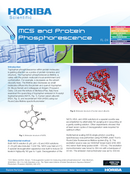

Multichannel scaling (MCS) single-photon-counting spectroscopy performed using HORIBA Jobin Yvon’s FluoroCube fluorescence lifetime system.
Tryptophan phosphorescence within protein molecules is gaining attention as a probe of protein dynamics and structure. The tryptophan phosphorescence lifetime, τ, varies with the protein molecule’s local environment and conformation. For example, τ decreases as the solvent viscosity rises. The lifetime also decreases as small molecules diffuse into the protein and quench tryptophan.
Dr. Bruce Kerwin and colleagues at Amgen (Thousand Oaks, CA) and the Istituto di Biofisica (Pisa, Italy) have examined the quenching of tryptophan emission in N-acetyl tryptophanamide (NATA), human serum albumin (HSA), and recombinant HSA (rHSA) using the HORIBA Jobin Yvon FluoroCube lifetime spectrofluorometer, which is a sensitive and important tool for investigation of the properties of proteins and changes in these proteins’ microenviroments1.
1 D.D. Banks and B.A. Kerwin, “A deoxygenation system for measuring protein phosphorescence”, Anal. Biochem. 324(2004), 106–114; G.B. Strambini, et al., The Triplet-state Lifetime of Indole Derivatives in Aqueous Solution”, Photochem. Photobiol. 80(2004), 462–470.
Steady State and Lifetime Benchtop Spectrofluorometer
TCSPC Lifetime Fluorometer
TCSPC/MCS Fluorescence Lifetime System
Masz pytania lub prośby? Skorzystaj z tego formularza, aby skontaktować się z naszymi specjalistami.
